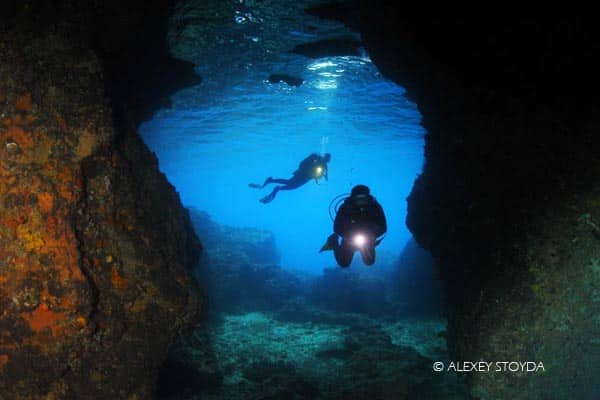What is Scuba Diving? History, Benefits, and Diving Locations in the Philippines
Learn everything you nee to know about about Scuba Diving and Scuba Diving in the Philippines.
What is Scuba Diving
People have been longing to discover what lies deep beneath the sea. Scuba diving makes this possible by allowing people to swim underwater without needing to hold one’s breath. Divers use SCUBA to breathe underwater, which stands for Self- Contained Underwater Breathing Apparatus. Unlike snorkeling, scuba diving allows you to go deeper into the sea and unlike freediving, it lets you stay longer in water.
Almost anyone can go scuba diving. As long as you are over 8 years old and without any serious medical condition, you can go scuba diving with adequate training. Even the disabled may be trained for scuba diving.
History of Scuba Diving
Scuba Diving History. The development of scuba diving started out when people needed to stay longer in water in search for food, sponges, pearl and shells. Later, it was used for military purposes as with the story of Scyllis around 500 BC. He was a Greek prisoner held captive by the Persian King Xerxes I aboard a ship. He escaped, jumped off the ship, and was not found. Later that night, he cut loose the anchorage of the ships underwater without the Persians noticing him. He used some kind of reed tubing as his snorkel to breathe underwater and swim for 15 kilometers more to return to his companions.
The concept of scuba diving was said to have developed from a diving bell developed during the 16th century. The bell with an open bottom is placed below the surface of the water with some air trapped on the top portion. The diver would go out of the bell mainly to collect sponges and return when they need to breathe. They do this until the compressed air becomes unbreathable.
On the same century, leather diving suits were used in France and England with manual pumps to supply air as deep as 20 meters. Improvements were made within 200 years that led to the development of steel and brass helmet and diving suits made of rubber for a more widespread commercial dive undertaking.
Technological advances on air pumps and other apparatus were also made possible with the help of Paul Bert and John Scott Haldane, who enlightened the people on the impact of water pressure on human body.
The first ever scuba equipment recorded, which later developed into the equipment that scuba divers are using now, was said to be invented by Benoit Rouquayrol and Auguste Denayrouse. It consisted of a diving helmet, a compressed air tank, and a simple demand regulator.
Many improvements were made to the scuba diving equipment during the 20th century to address problems like decompression sickness caused by deep sea diving. Later during the 1930s, fins made f rubber and masks made of glass were also devised for efficiency in swimming underwater.
In 1943, Jacques Cousteau and Emile Gagnan developed an improved demand regulator system, which later on became available to the masses. However, with the increasing popularity of scuba diving, the number of scuba-diving related accidents also rose. This prompted the formation of diving organizations like the National Association of Underwater Instructors (NAUI) in 1960 and the Professional Association of Diving Instructors (PADI) in 1966 to train and certify divers before venturing underwater.
Benefits of Scuba Diving
Today, scuba diving offers us many benefits. Most of the time, it allows us to see and enjoy the different underwater creatures, views, and even shipwrecks, making it a one-of-a-kind hobby and sport to enjoy. It gives many people jobs as scuba diving instructors and underwater photographers. Scuba diving is also being used by marine biologists to study life underwater. It plays a very important role when it comes to plotting maps, building and maintaining structures underwater, and participating in rescue operations. Other professions that take advantage of scuba diving also include police divers and military divers.
Types of Scuba Diving
There are many types of scuba diving that has been done and enjoyed by divers. These include:
- Cavern diving – diving within the entrance of a cave, where light is still visible.
- Cave diving – when more professional and skilled divers go more yards beyond the cavern and deeper into the cave.
- Deep diving – diving between 100 feet (30 meters) and 140 feet (40 meters).
- Night diving – diving and seeing completely different sea creatures and wonders at night.
- Wreck diving – diving to see wrecks of boats and ships, submarines, automobiles, and airplanes.
- Rescue diving – training to assist and rescue other divers that also boosts one’s self-confidence underwater.
- Drift diving – diving as if you are being carried away by the currents and having a sense of flying underwater
- Underwater naturalism – diving to scientifically learn, observe, and classify creatures in the aquatic world, such as vertebrates, invertebrates, and plants.
- Ice diving – penetration diving under ice
- Altitude diving – diving underwater where surface is 1000 feet (300meters) or more above sea level, such as diving in a mountain lake.
- Nitrox diving – diving with nitrox or enriched air, which combines nitrogen and oxygen that allows divers to stay longer underwater.
Best Scuba Diving Locations and Destinations in the Philippines
The Philippines is considered to be a popular diving spot in the world with about 40,000 square kilometers of coral reefs that house stunning plant and animal life underwater. The following diving spots in the Philippines are known to make your scuba diving experience truly worthwhile and exhilarating:
- Alona -located on the south-west tip of Panglao Island, one and a half kilometer long stretch of coral white sandy beach where resorts, dive centers, restaurants, and souvenir shops are.
- Cabilao – triangular shaped 7.2 square kilometer island that is located at the west of Bohol, facing Cebu island
- Malapascua – located in the northern tip of Cebu, Central VIsayas
- Dauin Dumaguete – Apo Island in Dumaguete located in the Negros Island, Visayas
- Moalboal – located in the southwestern coast of Cebu
- Mactan Island – located in Cebu
- Panglao and Balicasag Islands – located in Bohol, Visayas
- Subic Bay- located in Luzon Island great for wreck diving and underwater photography
- Boracay – located in Aklan in the Visayas Group of Islands
- Palawan – located in western part of the Philippines with diving destinations, including Calamian Islands, Coron bay, and El Nido
- Puerto Galera – located in Mindoro, 99 miles off Manila
Interested to have an awesome scuba diving experience in the Pilippines? Inquire now! Dive with a smile with Sea Explorers Philippines.




